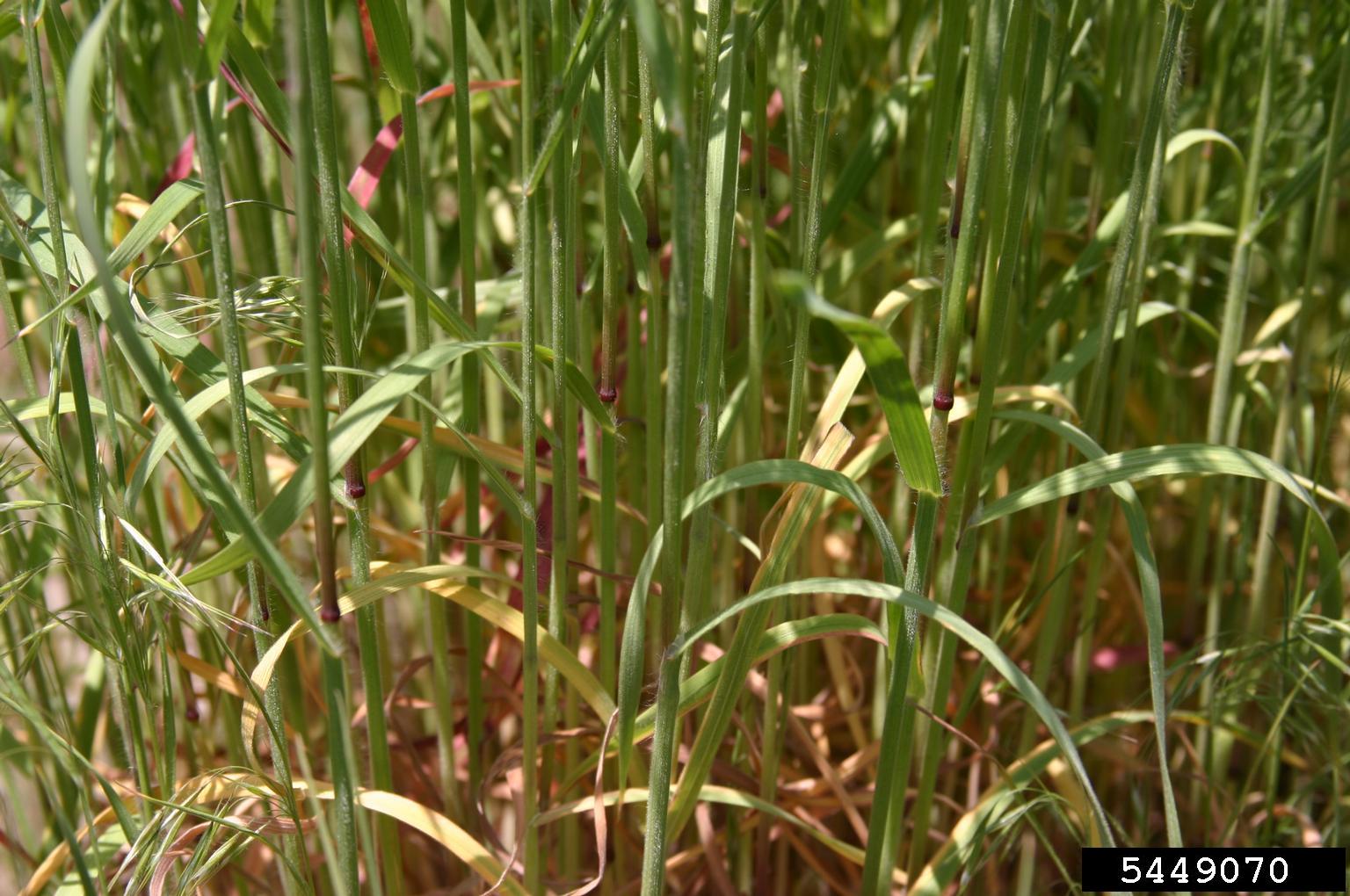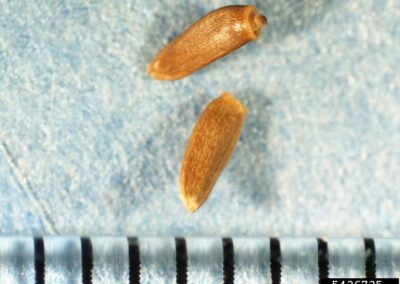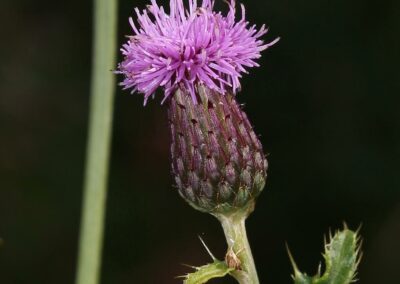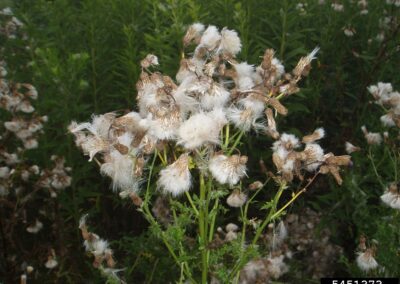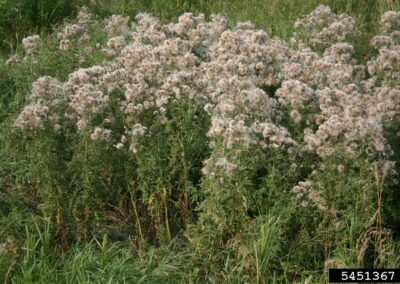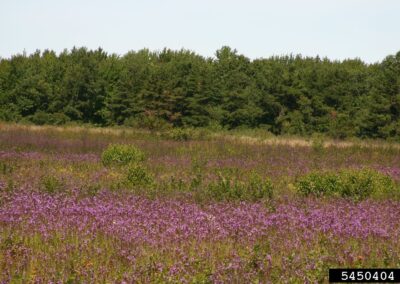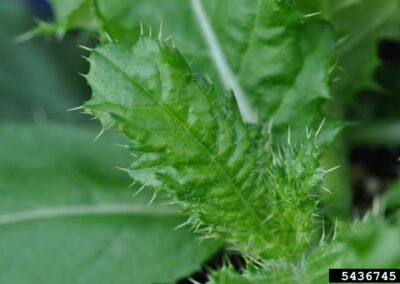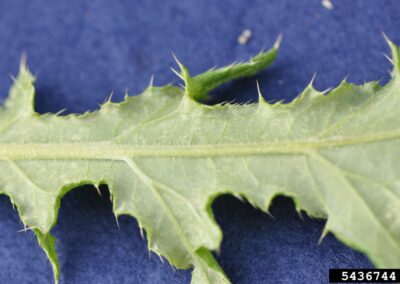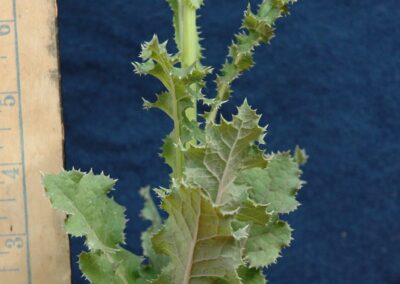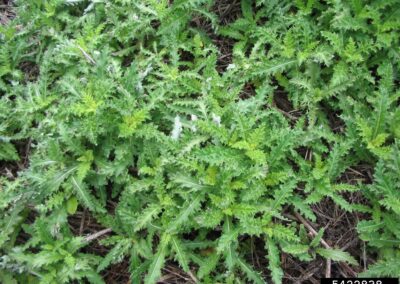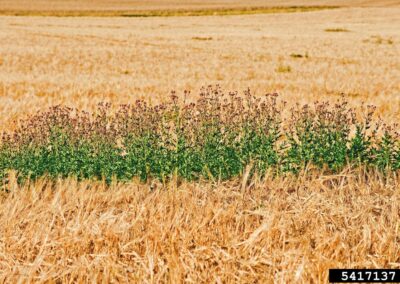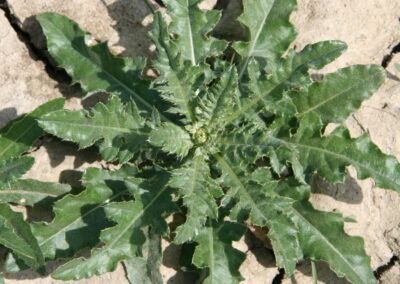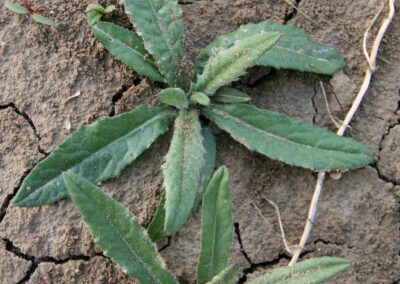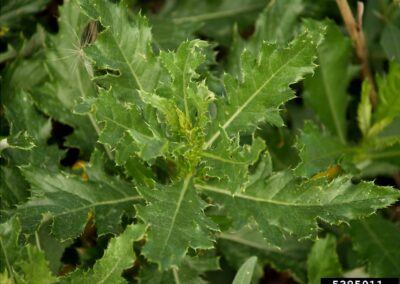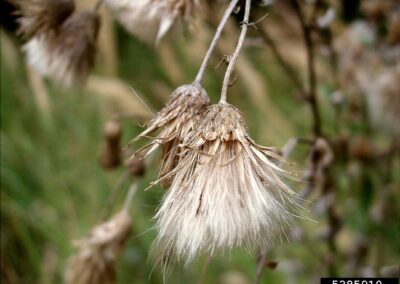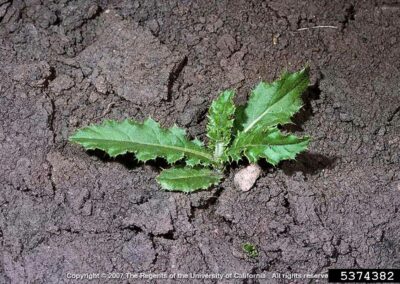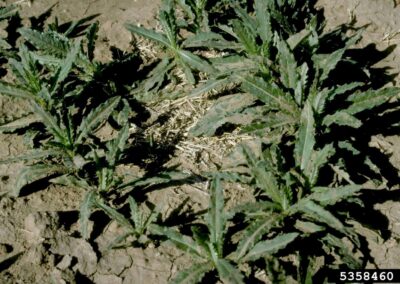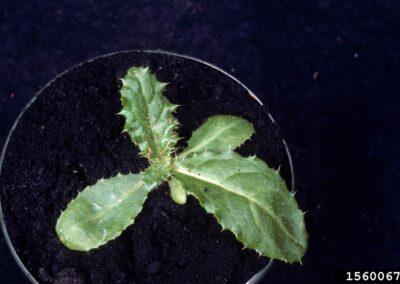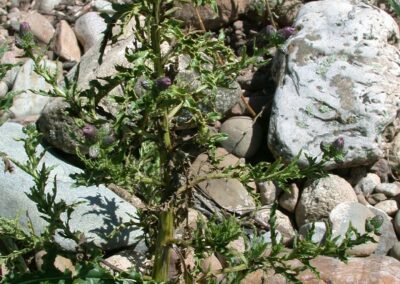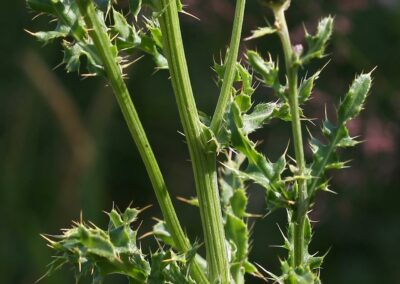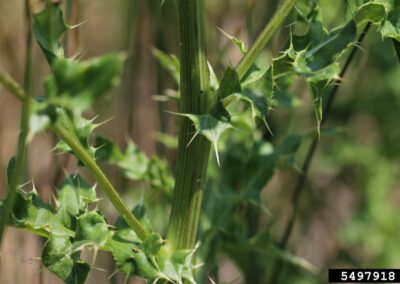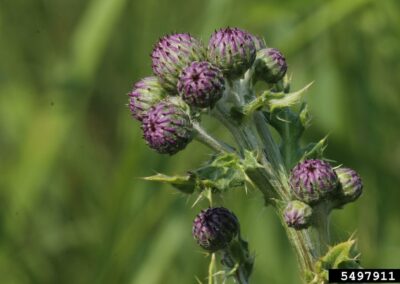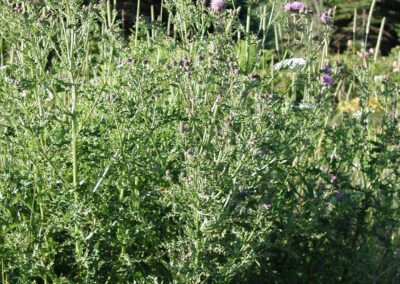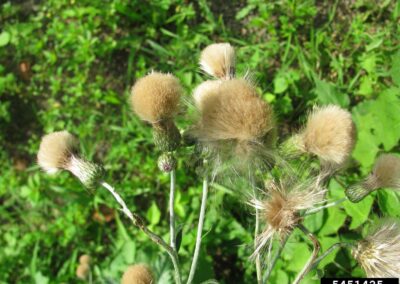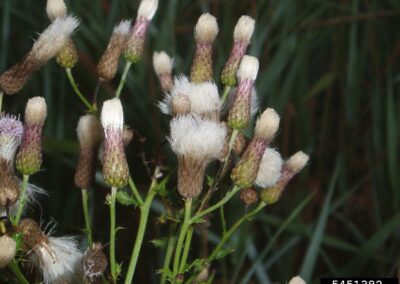
Canada Thistle
Cirsium arvense
Class A Noxious Weed
This plant is new to the state and has been designated a Class A Noxious Weed by the New Mexico Department of Agriculture.
Read more >>>
Agricultural Threat
This plant threatens our state's food security and economy by reducing agriculture yields and/or degrading soil resources.
Read more >>>
Wildlife & Ecosystems
This plant is detrimental to native ecosystems, negatively impacting the quality of forage for wildlife and reducing biodiversity in plant communities.
Read more >>>
QUICK FACTS
- Look out for this weed and don’t let it get established, because it’s very difficult to get rid of! Its expansive perennial root system spreads aggressively and spawns clones of itself, making it a nightmare for land managers across the world.
- It is allelopathic; it fills the soil with toxins, making it inhospitable to other plants. It degrades soil health over time.
- Its root system can reach 15 ft underground and an equal horizontal spread. Most direct management tools involve working with aboveground parts, so controlling a large infestation is a difficult and lengthy process.
- Native thistles are an important part of our ecosystem and a crucial food source for wildlife. Please protect them by learning to differentiate between Canada thistle and our rare and beneficial thistles. See Identification to learn more.
1. Overview
Meet the posterchild of noxious weeds! This invasive thistle has been a thorn in the side of landowners and farmers for centuries. Canada thistle was one of the targets of our nation’s very first noxious weed laws, and today is classified as a noxious weed in all 50 states.
Canada thistle is a tenacious and invasive weed that poses a significant threat to New Mexico’s landscapes and agriculture. Known for its sharp spines and extensive root system, this noxious weed can quickly take over pastures, fields, and even your backyard. Not only does it crowd out native plants and crops, but its deep spreading root system makes it exceptionally difficult to eradicate. It’s crucial to understand the impact of Canada thistle and the importance of early detection and control to protect your property and preserve New Mexico’s natural beauty.
History of Canada Thistle
Canada thistle, a perennial menace, has a storied history of wreaking havoc since its introduction to North America in the 1600s. It is one of the oldest agricultural pests, and has gained a variety of loving nicknames over the years, such as “devil’s thistle” and “lettuce-from-hell”.
Native to the Eurasian regions of the Mediterranean and Asia, as well as Northern Africa, C. arvense evolved in the agricultural waste of the early inhabitants of these regions. It specialized to grow in waste areas, organic residues, and fallow lands. It was in these areas of neglect that this plant adapted its troublesome spreading techniques, which have enabled its expansive reach across the world. Today, it is thought to have the largest range of any thistle.
It was first identified as an invasive plant in North America in the 17th century, in French Canadian territories where temperatures are cooler, but it was only a matter of time before it made its way into the southern latitudes, adapting to this new continent and its environments with each encroachment.
Botanists in these early days underestimated the aggressive and pernicious nature of this weed, relying on incomplete knowledge and assumptions. Many prominent botanists of the time engaged in the pervasive belief that Canada thistle simply did not produce seed at all. For a long time, people were not worried about its spread due to the idea that it did not seem to ‘seed’ (Hayden 1933). This common belief was not corrected until the 1920’s, when the dioecious nature of this plant was first reported. This lack of reliable information meant Canada thistle was allowed to spread unabated for decades. The situation would eventually be amended as its impact on agriculture and native ecosystems became untenable.
The first weed outlaw
With growing consensus about its detrimental economic impact on agriculture, Canada thistle found itself in the crosshairs of state legislatures. In 1795, the state of Vermont enacted the first noxious weed law in our country, specifically to fight the spread of Canada thistle. In the early 1900’s, the currently named Noxious Weed Act gave people the right to “eradicate Canada thistle wherever it occurred, without fear of trespassing” (Jacobs, 2006). By 1846, 21 out of the existing 25 states that enacted weed laws targeted Canada thistle; today, all 50 states do so. While the original text of many of these early laws is not readily available, the first noxious weed law of the state of Iowa, enacted in 1868, reads as follows:
Be it enacted by the General Assembly of Iowa, that if any resident owner of any land in this state after having been notified in writing of the presence of Canada thistles on his or her premises, shall permit them or any part of the root to blossom or mature, he or she shall be liable to a fine of five dollars and cost of collection for each offense. (April, 1868)
This invasive species has relentlessly spread across the United States, leaving a trail of agricultural and environmental destruction in its wake. In the Southwest, including New Mexico, Canada thistle’s aggressive growth and resilient root system have displaced native plants, reduced crop yields, and complicated land management. Its persistent presence over centuries underscores the critical need for vigilant control and management to protect our ecosystems and agricultural lands.
2. Identification
What does it look like?
Despite relying primarily on clonal reproduction, Canada thistle has a high degree of genetic variation between localized populations, making it difficult to reach universal descriptions. For the purposes of this guide, we are focusing on the features that distinguish it from other types thistles, but be aware individual plants may not all conform to the images/descriptions offered here. Having trouble identifying a weed? Contact us.
Key Features
- Flowers: C. arvense is dioecious, so the male and female flowers are found on separate plants; this distinguishes it from many other thistles (both native and invasive) that have both sets of organs in each individual plant. Flowers typically smaller than other invasive thistles, less than 1 inch in diameter and typically grow in clusters of 1-5
- Rosettes: Fairly weak rosette base with few, if any leaves. Compared to other thistles, leaves on basal rosettes of C. arvense are more tall and erect as opposed to laying flat along the ground. Rosettes from seed have dull green, relatively thick, rounded-oval to oblong cotyledons (seed leaves); clonal rosettes sprouted from the root lack these cotyledons (See images below).
- Leaves: Leaf shape varies greatly. Some display deep lobes, while some are narrow and thin. Like other thistles, the leaf margins are lined with spikes; on Canada thistle, the spikes are relatively fine and evenly spaced, does not tend to form large thorns. Upper surface is usually dark green, and smooth or slightly hairy; underside is lighter in color and covered with fine, white hairs.
- Stems: Erect, smooth or slightly hairy, typically with no spines. Often ridged, sometimes pinstriped purple or red due to disease or genetic variation. Shape can vary, but is almost always branching. Stems 18-48 inches tall, plants typically reach a height of 3-5 ft tall, though taller patches can form.
- Seeds: Tiny achenes; become “plumed” when mature, similar to dandelion seeds.
canadathistle-seeds
Seeds are brown and flat, approx 1/10 inch long, mostly straight to slightly curved, with a bump on one end. This tiny fruit disperses by means of a propeller-like pappus (similar to dandelion seeds)
canadathistle-flower
Canada thistle flowers are less than an inch in diameter and usually purple to pink in color, though white is also possible.
5451367
After a first flush of flowering, Canada thistle plants remain alive for at least another season.
canadathistle-monoculture
Canada thistle can rapidly cover a large area, forming dense monocultures that bloom purple in the summer
5436745
Canada thistle leaves vary greatly depending on growing conditions; some leaves have spine-like hairs growing along the tops of the leaves, giving a hairy appearance.
canadathistle-leafback
Leaves are relatively smooth, but the bottom can have tiny woolly hairs along the bottom, especially on the midrib
canadathistle-stemleaves
Canada thistle develop branches from a central stem with several large leaves emerging from it.
canadathistle-woodyinfestation
Natural forest ecosystems are also susceptible to Canada thistle invasions
canadathistle-outbreak
Canada thistle tends to co-exist within monocultures of other aggressive invasive weeds.
canadathistle-leaves
The leaves grow alternate on the stem and reach a length of 6 to 8 inches, and a width of 1 to 1.5 inches on mature plants
canadathistle-rosette1
Canada thistle can grow in many soil types, including rocky soils with high salt content
canadathistle-rosettes
New plants grow as basal rosettes the first year, before bolting the following year.
canadathistle-seedling1
Canada thistle can grow in all but the most water-logged soils; it likes well-aerated rocky soils with lots of oxygen.
canadathistle-seedling
Compared to vegetative clones, Canada thistle seedlings are susceptible to competition and shading from other plants.
canadathistle-flower
Canada thistle flowers are less than an inch in diameter and usually purple to pink in color, though white is also possible.
canadathistle-stem-flower
Canada thistle flowers are urn-shaped, emerging from branching stems lined with spikes
canadathistle-stem
The stems of Canada thistle are lightly ridged and are often stained purple, the alternate leaves are lance-shaped and lined with spikes.
canadathistle-flowerbuds
Canada thistle buds emerge in response to sunlight, usually in late spring or early summer.
canadathistle-infestation
Canada thistle takes over fields by spreading clones of itself through its expansive root system.
canadathistle-seedheads
Fluffy pappus becomes apparent in Canada Thistle after flowering when seeds have fully matured.
3. Infestation Basics
“Of the various agents by which Canada thistle is introduced, man is foremost.”
– Ada Hayden, 1933
Why is it so invasive?
Canada thistle is particularly aggressive due to its creeping root system, from which it sprouts clones, and due to the ease with which its tiny seeds transported as crop contaminants or on vehicles and equipment.
Canada thistle plants emerge in two possible ways:
- Vegetative spread: given a proper growth medium, it can start cloning itself from nearly any root tissues, including by extending out horizontally from its root system, from subterranean stem tissue, or even from root fragments as tiny as 0.2 grams (about the length of a pinky fingernail, or about 1/4th of an inch) in length.
- Reproductive spread: new plants grown from seed; viable seeds require the presence of both male and female plants for cross-pollination to occur; they are primarily pollinated by honey bees and are not wind-pollinated. New plants grown from seed develop their root systems quickly, and can start sprouting root clones of their own within the first year. Seeds are weakly wind-propelled and tend to land close to the mother plant, resulting in a characteristic circle-spread pattern. Canada thistle seeds spread into new regions primarily as contaminants in crop seed and as travelers on vehicles and equipment, though laws and regulations seek to stem this vector of invasive seeds. Learn how to prevent the spread of invasive seeds.
By leveraging both of these reproductive methods, Canada thistle colonies can rapidly extend over large areas; one plant can colonize an area 3 to 6 feet in diameter in just one or two years. Of the two, vegetative spread is much more common and problematic, often resulting in thickets composed of clones of the same sex (all female plants or all male plants).
Stemming reproduction from seed is relatively straight-forward and focuses on preventing the formation of seed by mowing, cultivation, or cutting off the buds. However, any direct management such as these have the potential of triggering the plant to sprout new root clones. Anytime the plant is stressed, and especially when root fragments are severed, it speeds up the production of new rosettes from the root system, thoroughly complicating the task of managing for this weed.
Key takeaway: Once Canada thistle is established, it is most important to exhaust the root system while avoiding directly disturbing it as this could further spread the infestation. On uninfested lands, preventing the spread of new seedlings is key.
Where does it grow and how does it spread?
Cirsium arvense is a common invader of agricultural soils of all kinds. It has evolved to exploit the organic residues left behind after cultivation or disturbance, so it especially targets fallow fields, pastures, garden beds, hedgerows, or otherwise “neglected” lands. Areas with organic waste or compost residues are also at risk.
This plant requires long days and full sunlight; it does not tolerate shade very well, and thus prefers open fields and pastures over forested landscapes. It thrives best in areas with abundant water supplies, but requires well-draining soils; its root system is intolerant of water-logging (as most non-wetland plants are). Water catchments and irrigated areas are common hosts of Canada thistle infestation.
All that being said, it is at this point well adapted to a wide variety of environments and conditions. According the Forest Service, it is found in meadows, pastures, disturbed forests, restoration sites, roadsides, and more. It rarely finds its way to undisturbed forests, and is not typically successful in such sites. However, the Forest Service does indicate that it is an issue in disturbed pinyon-juniper forests in the Southwest.
Key takeaway: While Canada thistle is adapted to a variety of conditions, it loves agricultural soils that have been neglected or overdisturbed, as it thrives in full sunlight and organic residues.
Common risk factors for invasion
- Human activity: Canada thistle thrives in areas where the soil has been disturbed, such as construction sites, agricultural fields, roadsides, and other places where the natural vegetation has been disrupted. These disturbances create openings in the soil that allow the plant to become established in the first place. Additionally, movement of soil, agricultural products, and equipment can inadvertently introduce Canada thistle to new areas.
- This risk can be reduced by properly cleaning heavy machinery and equipment, and by revegetating with competitive plants following the disturbance.
- Areas of neglect: Canada thistle is most likely to go unnoticed within neglected or poorly managed areas; the edges of fields, especially on fallow land, and wherever waste residues (such as compost or organic matter) accumulate are vulnerable. Practices such as overgrazing, lack of crop rotation, and inadequate weed control increase vulnerability to invasion.
- This risk can be mitigated by practices that move cattle around more frequently such as rotational grazing.
- Open spaces: Open sites with long days of full sunlight availability and little to no canopy are at risk for particularly aggressive infestations; pastures, pastures, fields, open grazing allotments, etc.
- Moisture availability: While Canada thistle has adapted to a wide range of soil and water conditions, it does generally requires adequate moisture to establish and spread, making irrigated lands and areas with consistent rainfall particularly vulnerable. Permanent waterlogging will kill the plant, so infestations are more pernicious on sites with well-draining soil.
Impacts
Agriculture and Food Security
This invasive weed easily outcompetes field crops such as alfalfa, canola, and winter and spring wheat for vital resources like sunlight, nutrients, and water. Its rapidly spreading root system quickly establishes dense stands that crowd out valuable crops; field infestations can reach densities of 173 shoots per square meter, severely impacting the space available for crop production. Yield losses can range from 25% to almost 50% depending on the crop (McClay, 2002). Additionally, Canada thistle serves as a host for other major agricultural pests, such as bean aphid, sod-web worm (which attacks corn), and stalk insects that damage tomatoes.
Canada thistle is also a major challenge for pastures and grazing lands. While some livestock can be trained to consume the rosettes as a management strategy, it is generally unpalatable and unattractive as forage due to its spines (Davis et al., 2018). Dense infestations can even injure animals, leading to infections, further deterring its use by livestock. The result is that livestock will selectively graze around the thistles, further facilitating its dominance on pastures (Michigan Dept. of Nat. Res., 2018).
In summary, farmers and ranchers face increased costs associated with managing this weed, including expenses for herbicides, additional labor, and mechanical control measures. Furthermore, Canada thistle can harbor pests and diseases that may affect crops, exacerbating the threat to food production. The economic burden on farmers and the potential for decreased food supply contribute to the overall negative impact on food security in the region.
Soil Degradation
We’ve discussed the threat that Canada thistle poses to agriculture by competing for resources and reducing land productivity. In addition to those direct threats, Canada thistle also poses indirect threats to agriculture and natural resource conservation on the landscape by negatively impacting the quality of our soil.
Canada thistle contributes to soil degradation in New Mexico by altering the natural soil composition and structure. It is known to be an allelopathic plant, which means that it exudes chemicals into the soil that are toxic to surrounding plants. Long term infestations can result in soil with significantly reduced fertility, making it much more difficult for other plants to grow.
This plant also uses large amounts of water, gradually drying out the soil and increasing its erosion potential. While its root system can be quite extensive, it is somewhat brittle and concentrated primarily in the shallow layer of soil, making it less effective at holding onto soil over time compared to other plants. Soil erosion not only reduces soil fertility but also affects water quality in nearby water bodies, as eroded soil particles can carry nutrients and pollutants into streams and rivers. Additionally, the dense growth of Canada thistle can hinder the regeneration of native vegetation, leading to long-term soil health issues and further degradation.
Native Ecosystems and Biodiversity
The invasion of Canada thistle poses a significant threat to native ecosystems in New Mexico, including to our rare and endemic thistles.
This aggressive weed outcompetes native plants for resources, and given its tendency to form dense monocultures, it reduces biodiversity and disrupts the balance of native plant communities in large areas; this results in heavily degraded habitat for wildlife, including pollinators that depend on a variety of flowering plants. Invasions of this plant will overcrowd and outcompete almost any native forb community. Unlike many native plants, new shoots can develop in early spring through late fall, giving it an unfairly long growing season. Attempts to remove the extensive roots will inevitably leave fragments behind, which will aggressively repopulate before native species can get established (USDA, 2014).
The threat is especially pronounced for our native thistles. New Mexico is home to a variety of rare native thistle plants, many of which can easily be confused with noxious thistles like C. arvense. Native thistles are beautiful, unique, and important components to regional ecosystems, such as providing food for flocks of songbirds and pollinators, as well as serving as hosts for endangered butterflies and moths. While Canada thistle and other exotic thistles can provide some of these services, they do so in a diminished capacity and cannot cover all of the needs that our native varieties do.
The Xerces Society provides the following summary:
As with so many of our other native prairie and meadow species, thistles have been a direct casualty of habitat loss […] Most significantly, the invasion of non-native thistles and the lack of discernment between superficially similar native and invasive species is heralding the potential end of these beautiful and important plants. A number of native thistles are now threatened with extinction.
In fact, in response to the spread of exotic invasives such as Canada thistle (C. arvense), expansive biocontrol programs have released alien thistle-eating insects that devour invasive and native thistles alike. These biological control efforts have had only limited impacts on some invasive thistles, but likely devastating impacts on our native ones. This pressure has been compounded by farm-level thistle eradication efforts, including the ever-increasing use of herbicides. And, finally, some broad-reaching weed control policies treat all members of the genus as noxious weeds, ignoring the potential to push historically common native thistles toward local extinction.
The displacement of native species can result in cascading effects throughout the ecosystem, affecting the entire food web, from birds to elk, and even us (See Agricultural impacts above). Moreover, Canada thistle’s rapid spread and establishment in natural areas make it difficult to control, necessitating ongoing management efforts. The long-term presence of this invasive species can fundamentally alter ecosystem functions and reduce the resilience of native habitats, making them more susceptible to other environmental stressors, such as drought, pests, and wildfires. Due to the potential impact to native thistles, it is of utmost important to properly identify Canada thistle and to evaluate our management efforts carefully in order to protect our natural resources.
4. Management Strategies
As a perennial thistle, it is most important to address the spread of the underground root system. Root systems can spread very rapidly across a large area and can reach deep in the soil; for that reason, prevention is the best approach.
New plants can sprout from small fragments of root, so consider carefully before disturbing the area where the plant is growing. Any disturbance (such as fire, grazing, or even hand-pulling) that damages the root or stresses the plant has the potential to stimulate its growth through root germination.
The root system acts as a storage for energy throughout the dormant season. When dealing with established infestations, the best approach is to deplete its stored energy through repeated, frequent disturbance, such as multiple rounds of mowing. Persistence is key; if energy stores are not depleted, management attempts may actually wind up making the situation worse.
DO’s
- properly ID the plant and any rosettes before attempting to manage; native thistles are an important part of our ecosystem and can look very similar to C. arvense
- exhaust nutrient reserves by repeatedly stressing plant over several growing season
- communicate with neighbors and businesses about the presence of this weed and take care not to transport seeds to new locations
DON’Ts
- wait until the infestation has spread to a large area; prevention and early detection are the best management strategies
- cultivate or hand-pull the plant, as any small fragments left behind will help spread the infestation
- rely on a single management strategy; combining multiple approaches is necessary to combat Canada thistle
** The following information is provided courtesy of the UC Weed Research and Information Center. The Taos Soil and Water Conservation District does not endorse the use of any particular product, brand, or application thereof. **
Quick summary of managing Canada thistle using non-chemical methods.
Mowing |
Mowing can be used to reduce the nutrient storage in the roots and suppress flower formation. However, for mowing to be effective it must be repeated at least every 3 to 4 weeks over several growing seasons or coupled with other control practices. |
Tilling/Hand-pulling, etc |
**NOT RECOMMENDED** Tillage or cultivation can actually increase Canada thistle because it breaks the root system into fragments, spreading the roots through the soil and stimulating development of new plants. Small root pieces have enough stored reserves to develop new plants. Small roots can survive at least 100 days without nutrient replenishment from photosynthesis. For cultivation to be effective it must be repeated at 21 day intervals throughout the growing season. |
Grazing |
Since Canada thistle spreads primarily via expanding its root system, grazing of above ground forage has not been proved to be an effective reduction strategy. However, livestock can be trained to eat Canada thistle; while it will not do anything to prevent root spread, properly timed grazing can be used to reduce seed prooduction by preventing flower formation. |
Prescribed burns |
Canada thistle is adapted to survive fire and to take over recently burned areas, so burns are not recommended as a control strategy. |
Please Be Aware: biocontrol agents are living organisms; they do not differentiate between different types of thistles. Some of these biocontrol agents can go on to become invasive species in their own right as they form outbreaks within crucial native thistles.
The following insects have been released as biocontrol agents, but none of these species have had a significant impact on Canada thistle.
Ceutorhynchus litura
|
The larvae of the Canada thistle stem weevil (Ceutorhynchus litura) bore into the main leaf vein and then into the crown. It is considered the most effective of the current biocontrol agents, reducing plant vigor. When present in high enough densities it can kill the plant. |
Larinus planus |
Larvae of the bud weevil (Larinus planus) feed on the bud and can reduce the potential for sexual reproduction. |
Urophora cardui |
Larvae of the thistle stem gall fly (Urophora cardui) bore into the apical meristem of shoots and form a gall. They can reduce plant vigor and can prevent flower formation depending upon the location of the gall. |
Puccinia punctiformis |
A pathogenic rust (Puccinia punctiformis) infects Canada thistle (mix sap from infected plant with water and spray uninfected plants to infect them), but it too has not had a significant effect on its control. |
Information regarding chemical management strategies for this plant has been provided by the UC Weed Research and Information Center.
“The following specific use information is based on published papers and reports by researchers and land managers. Other trade names may be available, and other compounds also are labeled for this weed. Directions for use may vary between brands; see label before use. Herbicides are listed by mode of action and then alphabetically. The order of herbicide listing is not reflective of the order of efficacy or preference.”
2,4-D
|
|
Aminocyclopyrachlor +
|
|
Aminopyralid
|
|
Clopyralid
|
|
Dicamba
|
|
Picloram
|
|
Glyphosate
|
|
Chlorsulfuron
|
|
Imazapyr
|
The herbicide label indicates that 4 to 6 pt product/acre gives some level of control, but imazapyr is not usually the herbicide of choice for the control of Canada thistle. |
Sulfometuron
|
|
5. Gallery
NMSU’s Extension Weed Specialist Dr. Leslie Beck on Canada thistle
This video is specific to Canada thistle in Taos County and was the result of a collaboration between Taos Soil & Water Conservation District and New Mexico State University.
6. References & Further Reading
References
- Davis, S., et al. (2018). A meta-analysis of Canada thistle (Cirsium arvense) management. Weed Science, 66(4), 548-557. doi:10.1017/wsc.2018.6
- U.S. Forest Service. (2014). Field Guide for Managing Canada Thistle in the Southwest. U.S. Department of Agriculture. Retrieved from www.fs.usda.gov/Internet/FSE_DOCUMENTS/stelprdb5410109.pdf
- Hartzler, B. (n.d.) “A brief history of Canada thistle in Iowa”. Iowa State Weed Science Online. Retrieved from crops.extension.iastate.edu/encyclopedia/brief-history-canada-thistle-iowa
- Jacobs, J., et al. (2006) “Ecology and Management of Canada Thistle”. U.S. Dept. of Agriculture, Natural Resource Conservation Service. Retrieved from www.nrcs.usda.gov/plantmaterials/mtpmctn13102.pdf [PDF]
- McClay, A.S. (2002) Canada Thistle. In Van Driesche, R., et al., Biological Control of Invasive Plants in the Eastern United States. USDA Forest Service Publication FHTET-2002-04, 413 p. Retrieved from www.invasive.org/biocontrol/17CanadaThistle.cfm
- Michigan Department of Natural Resources. (2018) “Canada Thistle”. In: Michigan Natural Features Inventory [March 2018]. Retrieved from mnfi.anr.msu.edu/invasive-species/CanadaThistleBCP.pdf [PDF]
- Zouhar, K. (2021). Cirsium arvense. In: Fire Effects Information System, [Online]. U.S. Department of Agriculture, Forest Service, Rocky Mountain Research Station, Fire Sciences Laboratory (Producer). Retrieved from www.fs.usda.gov/database/feis/plants/forb/cirarv/all.html
Further Reading
- New Mexico Thistle Identification Guide [PDF] by the Native Plant Society of New Mexico
- Native Thistles: A Conservation Practitioners Guide [PDF] by the Xerces Society for Invertebrate Conservation
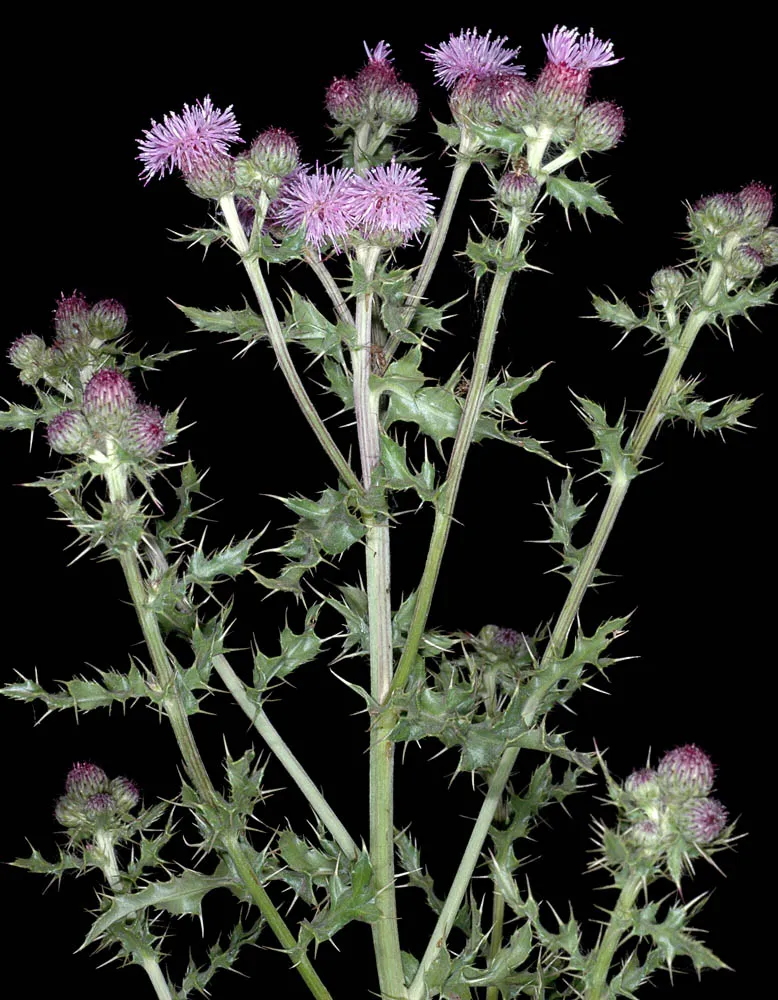
Canada Thistle plant with blooms
Did you know?
Canada thistle inspired the very first noxious weed laws in America, first in the state of Vermont in 1795, with other states following suit. Some laws were broad enough to allow anyone the right to trespass onto a property in order to eradicate Canada thistle wherever it was found, but more commonly were comprised of fines on landowners for hosting the plant on their property (See History).
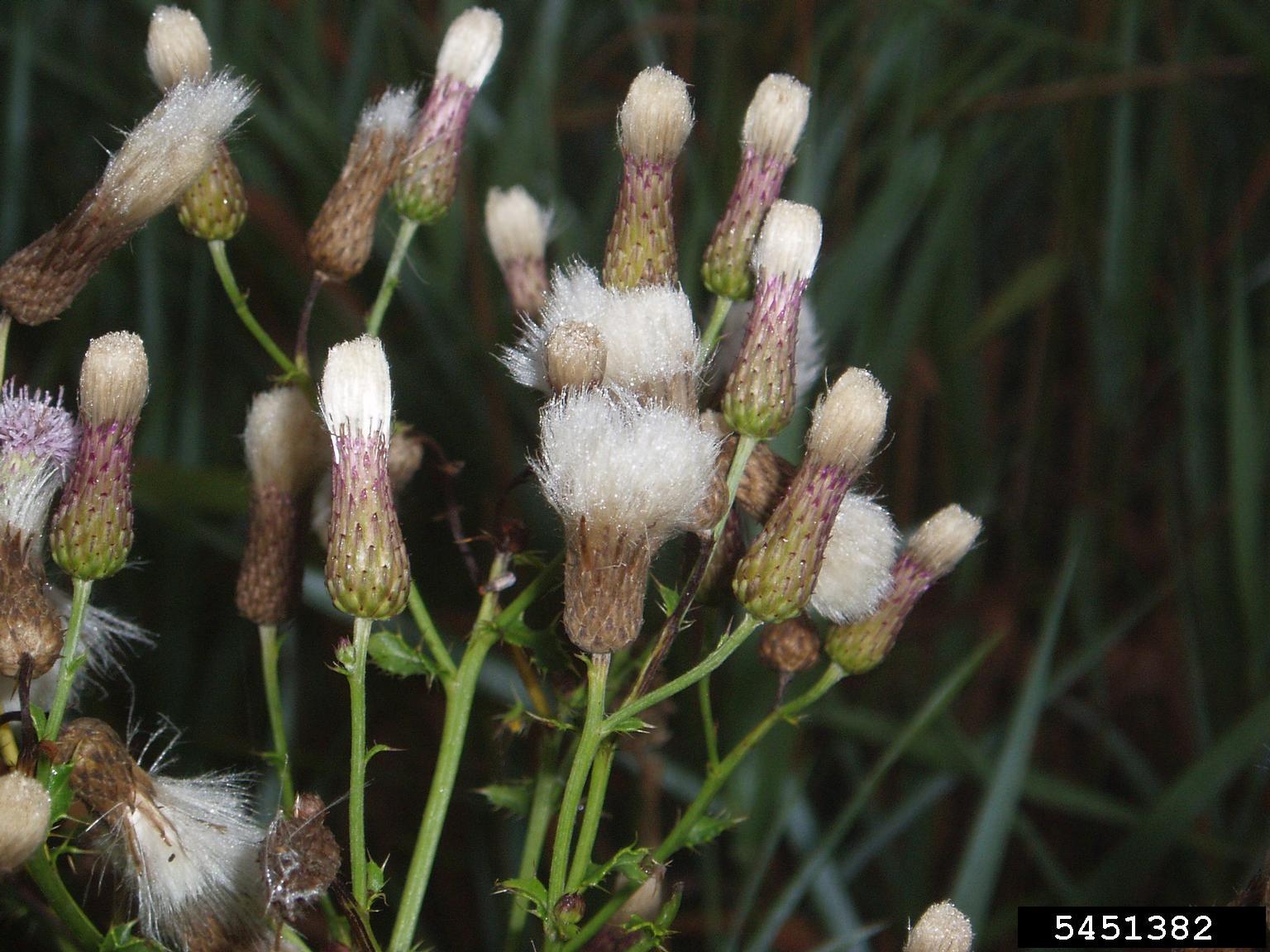
Photo (c) Leslie J. Mehrhoff, University of Connecticut, Bugwood.org
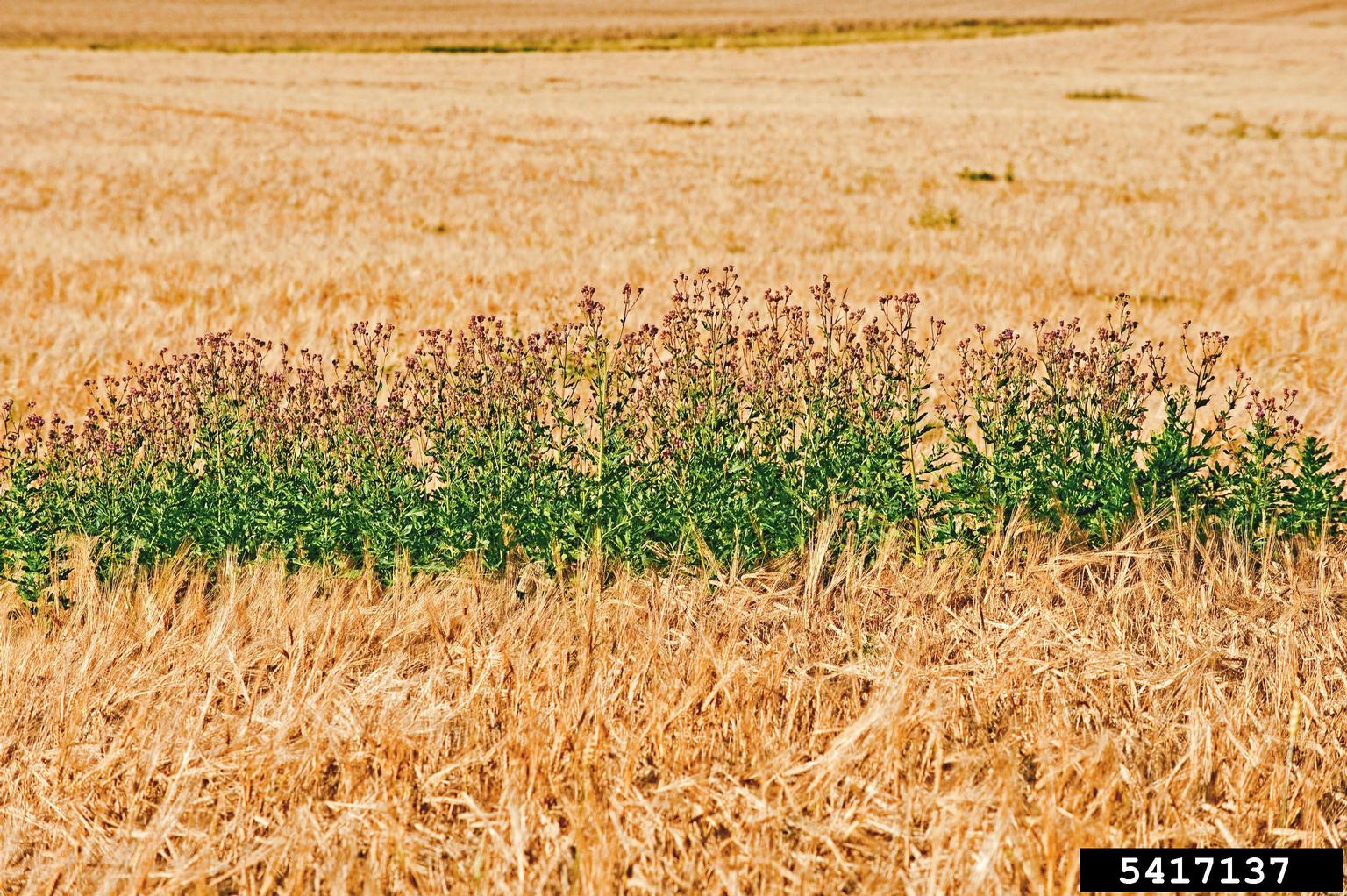
Photo (c) Bonsak Hammeraas, NIBIO – The Norwegian Institute of Bioeconomy Research, Bugwood.org
Did you know?
Canada thistle is not Canadian at all! The name “Canada thistle” comes from early New England residents who blamed the introduction of this plant on French traders up north; some believed the introduction may have been intentional, although in all likelihood it was introduced accidentally.
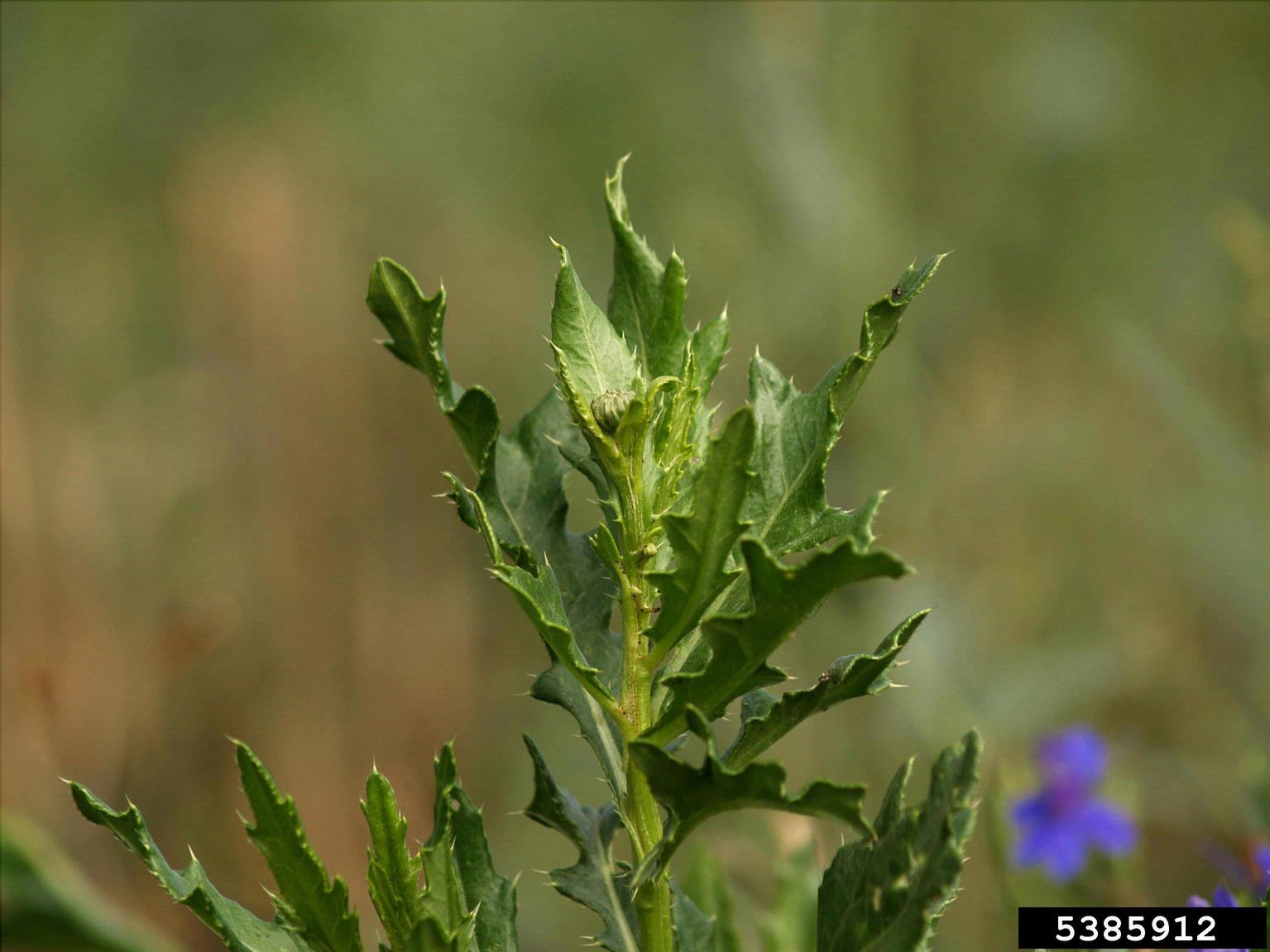
Photo (c) Jan Samanek, Phytosanitary Administration, Bugwood.org
